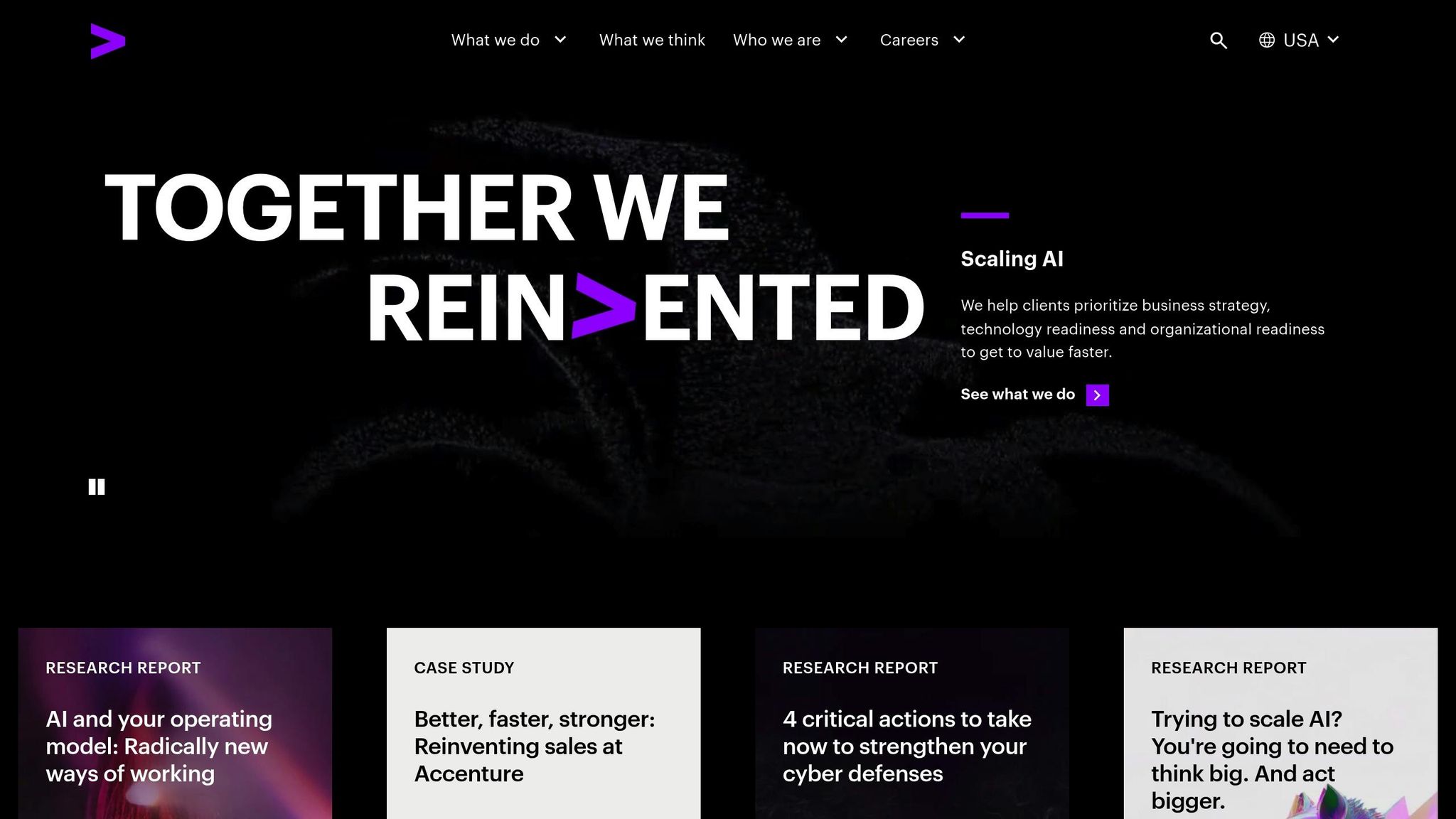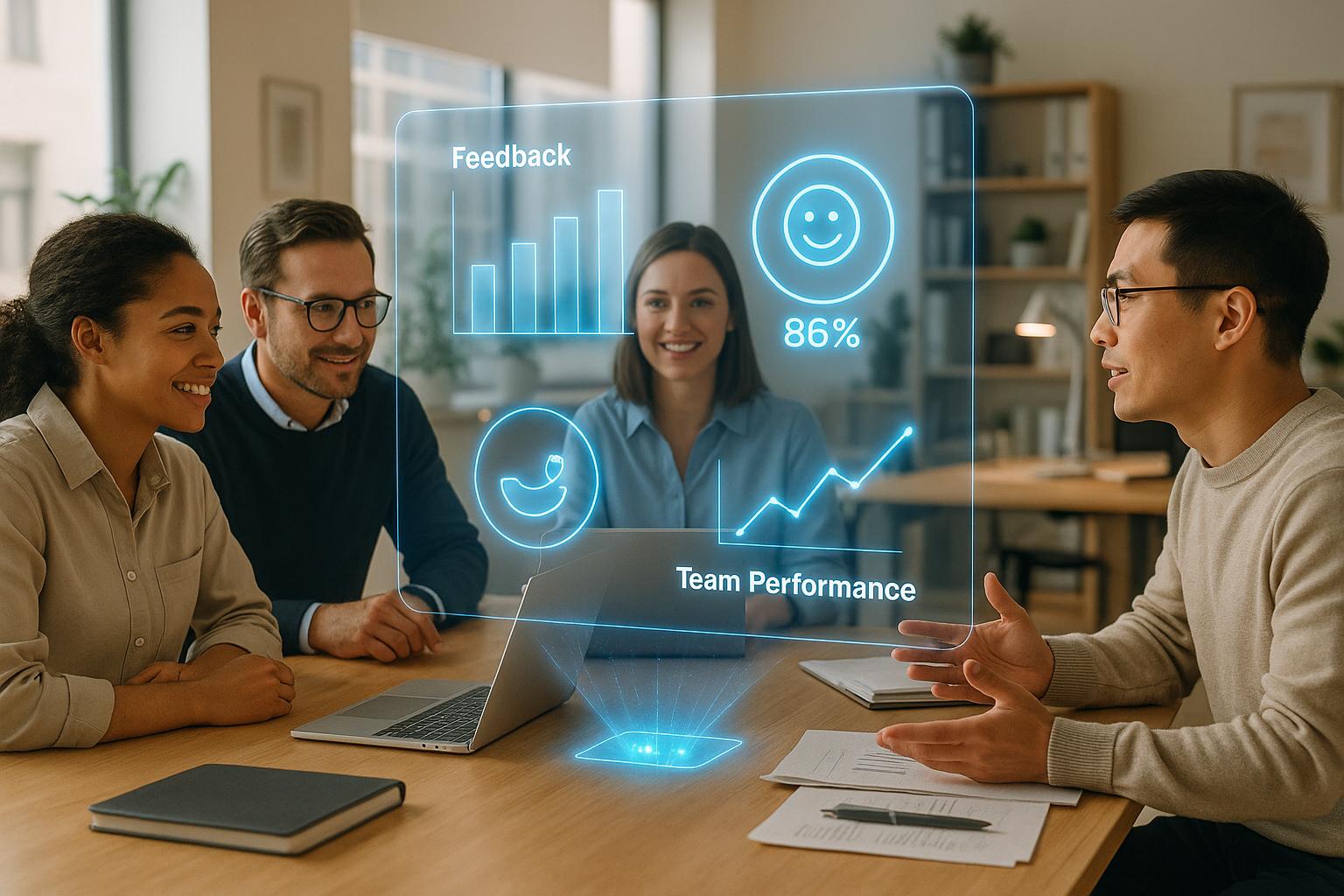AI-powered feedback systems are changing how teams improve and communicate. Unlike outdated performance reviews, these tools provide real-time, data-driven insights to help employees grow, reduce bias, and improve teamwork. Companies using these systems report:
- 30% higher employee engagement
- 25% lower turnover rates
- 20% productivity gains
By analyzing communication patterns and task progress, these systems deliver immediate, actionable recommendations. They also address common issues like delayed feedback, bias, and communication breakdowns. Tools like Worklytics and Aidx.ai are already helping organizations achieve faster project timelines and better collaboration.
AI feedback systems not only save managers time but also ensure employees feel supported and recognized, creating healthier workplace dynamics. Ready to transform your team’s feedback process? Here’s how they work and why they matter.
How Accenture is Using AI to Transform Employee Feedback

Problems with Traditional Team Feedback Systems
Many organizations still rely on outdated feedback methods that hinder their teams’ ability to thrive. These traditional systems often leave employees feeling frustrated, disengaged, and stuck in a cycle of missed opportunities. The main culprits? Poor timing, bias, and communication breakdowns that only worsen over time.
Delayed and Infrequent Feedback
Annual performance reviews are one of the biggest offenders. With over 70% of organizations moving away from this outdated model, it’s clear that these reviews fail to address issues effectively[11]. The delays mean problems are often tackled long after they’ve already caused damage, widening gaps in performance.
This delay has a ripple effect on team dynamics. When employees don’t receive timely feedback, they feel undervalued and unsupported. A study showed that companies transitioning to real-time feedback saw a 30% boost in employee engagement within just six months[3]. That kind of improvement underscores just how much potential is wasted when feedback arrives too late to make a difference.
Infrequent reviews also miss the nuances of daily collaboration. Employees may excel in specific areas that go unnoticed or struggle with challenges that could be easily resolved with immediate guidance. These gaps in recognition and support can leave teams feeling overlooked and disconnected.
But timing isn’t the only issue – bias plays a significant role in undermining the effectiveness of traditional feedback systems.
Subjective Bias and Lack of Objectivity
Unconscious biases are another major flaw in traditional feedback methods. Factors like personal preferences, recent interactions, and misunderstandings can all skew a manager’s assessment of team performance. Biases such as favoritism or focusing only on recent events erode trust and morale[11].
In fact, a 2023 Gallup study found that only 26% of employees strongly agree that the feedback they receive helps them improve their work[11]. This low level of satisfaction highlights how subjective evaluations often fail to provide actionable insights that employees can actually use.
Bias becomes even more problematic in diverse teams. Differences in communication styles, work habits, and collaboration preferences can lead to unfair assessments if managers don’t account for these variations. Instead of evaluating performance, traditional systems can unintentionally penalize employees for cultural differences, creating further frustration and disengagement.
Communication Bottlenecks and Misunderstandings
Another critical issue with traditional feedback systems is the lack of clear and direct communication. Feedback is often vague, delayed, and overly generic, leaving employees unsure of what they need to improve. This one-way communication style creates confusion and prevents meaningful progress.
Communication bottlenecks occur when feedback has to pass through multiple layers of management. By the time it reaches employees, it may be watered down, misinterpreted, or completely disconnected from its original intent. These breakdowns turn potentially constructive guidance into a muddled message that leaves teams guessing.
Organizations that improved feedback clarity using AI tools saw impressive results: a 15% rise in customer satisfaction and a 25% drop in employee turnover[3]. These numbers show how much teams can benefit when communication barriers are removed, and feedback becomes clear and actionable.
Traditional manual processes only add to the problem. Managers, pressed for time, often rush through evaluations, offering surface-level comments that fail to address root causes or provide specific solutions. To overcome these challenges, modern teams need feedback systems that prioritize clarity, immediacy, and actionable insights.
Recognizing these flaws is the first step toward understanding how AI-driven solutions can transform team feedback systems.
How AI-Powered Feedback Systems Fix These Problems
AI-powered feedback systems address the challenges that traditional feedback methods often face. By replacing delayed and subjective reviews with continuous, data-driven insights, these systems improve communication and foster team growth. The real-time nature of these tools ensures that feedback is actionable and timely, eliminating the inefficiencies of periodic reviews.
Real-Time Performance Insights
One of the biggest drawbacks of traditional feedback is its delay. AI systems solve this by constantly collecting and analyzing data from tools like project management software, communication platforms, and peer reviews [1][2][4]. This ongoing monitoring means employees receive immediate, actionable insights instead of waiting for formal review cycles.
For instance, Worklytics uses AI to track collaboration patterns, helping teams reduce meeting times and speed up project timelines [10]. These systems also flag potential issues early – such as excessive after-hours work or communication overload – allowing managers to intervene before problems escalate. This proactive approach creates an environment where continuous improvement becomes the norm.
Removing Bias with Data-Driven Evaluations
Bias is another common issue in traditional feedback systems, often influenced by personal preferences or inconsistent criteria. AI systems tackle this by focusing on measurable outcomes and applying uniform standards across the board [1][2][6].
Take IBM as an example. In 2022, the company used AI to predict employees at risk of burnout or disengagement [5]. By leveraging these insights, IBM developed personalized wellness and career growth programs, which not only reduced turnover but also improved workplace morale. These systems can also suggest optimal team structures and pairings for brainstorming based on previous collaboration data [5][12]. Studies show that teams combining human and AI input often achieve better creativity and efficiency than human-only groups [10].
Natural Language Processing for Better Communication
Clear and effective communication is vital for any team, and Natural Language Processing (NLP) plays a key role here. By analyzing language patterns, NLP tools detect sentiment, simplify technical language, and even automate scheduling, ensuring feedback is precise and easy to act on [1][7].
NLP also bridges language and time zone gaps, offering real-time translations when needed [13]. Instead of vague comments, these tools turn feedback into clear, actionable guidance, reducing misunderstandings. Aidx.ai’s Adaptive Therapeutic Intelligence (ATI) System™ is a great example. Using evidence-based methods like Cognitive Behavioral Therapy (CBT) and NLP, this system provides personalized coaching in real time. Its voice-enabled interface and privacy-first design make it a practical solution for enhancing team communication and performance.
sbb-itb-d5e73b4
Key Benefits of AI-Powered Feedback Systems
AI-powered feedback systems are transforming how teams operate, delivering measurable improvements in areas like employee engagement, collaboration, and efficiency. Companies adopting these tools often see tangible results, including higher satisfaction, increased productivity, and smoother operations within just a few months.
Higher Employee Engagement and Retention
These systems create a more supportive and engaging workplace by offering continuous recognition and growth opportunities. Instead of waiting for annual reviews, employees receive timely, actionable feedback, helping them feel appreciated and connected to their roles.
For example, organizations have reported a 30% rise in employee engagement and a 25% decline in turnover after implementing AI feedback tools [3]. In 2024, ONES Project introduced such a system at a global tech firm, leading to a 32% boost in project completion rates and a 15% drop in employee turnover within six months [11]. By analyzing individual work habits and communication styles, these tools deliver personalized insights, showing employees clear paths for growth and reducing frustrations that often trigger job changes.
Better Team Collaboration and Productivity
Beyond individual engagement, AI-powered feedback systems also strengthen teamwork. They identify communication gaps and workflow bottlenecks, offering insights that improve how teams interact and achieve shared goals.
Nearly 58% of organizations using AI feedback tools report better collaboration and morale, with productivity increasing by 20% due to faster issue resolution and improved goal alignment [3][1]. A great example is Asana‘s AI features, which helped a global marketing team cut missed deadlines by 28% and improve cross-team communication by summarizing meeting notes and assigning tasks based on availability [9].
These systems even predict potential conflicts and workload imbalances, allowing teams to address issues before they cause delays.
Streamlined Feedback Processes and Time Savings
Traditional feedback processes often require managers to spend significant time on manual reviews and administrative tasks. AI automation changes this by creating a continuous feedback loop with minimal human effort.
Automation can reduce administrative feedback tasks by up to 40%, giving managers more time to focus on strategic coaching [8][9]. With automated summaries, managers no longer need to spend hours on lengthy reviews.
This approach benefits everyone. Employees get feedback when it’s most relevant, managers can address performance concerns promptly, and HR teams enjoy reduced administrative workloads. Companies using these systems report up to a 30% increase in productivity and a 25% reduction in project delays, thanks to improved communication and workflow management [11]. When integrated with project management tools, communication platforms, and HR systems, these AI tools create a seamless feedback ecosystem, eliminating data silos and ensuring performance insights are always accessible.
These advancements highlight how AI-powered feedback systems are reshaping team dynamics, offering real-time, unbiased evaluations that lead to stronger, more effective teams.
How to Implement AI-Powered Feedback Systems
Rolling out AI-powered feedback systems isn’t just about plugging in new technology – it’s about thoughtful planning and execution. Without preparation, organizations risk running into resistance, low adoption rates, and underwhelming results. A structured approach, on the other hand, can pave the way for success. Here’s how to set clear goals, secure data, and prepare your teams for implementation.
Setting Clear Goals and Objectives
Start by defining what you want the AI system to achieve. How can it help solve your team’s most pressing challenges? For example, are employees feeling disconnected because of late performance reviews? Are communication breakdowns between departments causing project delays? Or perhaps managers are overwhelmed with administrative tasks, impacting their ability to lead effectively? Each issue points to specific AI capabilities and success metrics.
Once challenges are identified, tailor your tracking metrics to match your priorities. For instance, if speeding up performance reviews is the goal, measure the time saved. Regularly assess these metrics – quarterly reviews work well – to ensure they stay relevant as your organization evolves. Adjust the focus of your AI system as needed to keep it aligned with your team’s objectives.
Protecting Data Privacy and Security
With goals in place, the next step is ensuring data privacy and security. Employee trust is critical – if people are uneasy about how their data is handled, they’re less likely to engage with the system fully, which can limit its effectiveness.
To build trust, encrypt data during storage and transmission, and limit access based on roles. If you operate internationally, comply with GDPR, even if your company is based in the U.S. This means giving employees control over their data, allowing them to access their information, and enabling them to request its deletion when appropriate. Many AI systems also include features like private modes for sensitive feedback, where data is automatically cleared after a set time.
Create a clear privacy policy that explains who can access employee data, how it’s secured, and whether it’s shared with third parties. Make this policy easily available and easy to understand. Regularly – at least quarterly – review your system’s security protocols to catch vulnerabilities before they become serious problems.
Training Teams to Use AI Tools
Even the most advanced AI feedback system won’t deliver results if teams don’t know how to use it. Training is essential, not just at launch but as an ongoing process. Teams need to learn how to navigate dashboards, interpret insights, and balance AI recommendations with their own judgment.
Focus training on real-world scenarios your teams encounter. For example, show how AI-generated insights about communication patterns can complement an understanding of individual work styles. To address skepticism, involve employees in the system’s selection and rollout. When people see how the tool benefits their daily tasks, they’re more likely to get on board.
Set up a support system for questions and troubleshooting. Assign "AI feedback champions" within departments to offer peer-to-peer help and gather feedback for future improvements. Pilot programs can also be a smart way to refine training materials and smooth out any issues before rolling the system out company-wide. This approach helps minimize hiccups and sets the stage for long-term success.
Conclusion: Changing Team Feedback with AI
AI-powered feedback systems are reshaping the way teams communicate, collaborate, and grow. By tackling challenges like delayed responses, subjective bias, and communication breakdowns, these systems provide a stronger framework for effective teamwork. The results are clear: organizations using these tools see tangible improvements in team dynamics.
The numbers speak for themselves. Companies that have adopted AI-driven feedback tools report up to a 30% boost in employee engagement, a 20–25% rise in productivity, and a 25% drop in employee turnover[3]. These improvements reflect workplaces where individuals feel recognized, connected, and motivated to contribute.
What sets these systems apart is their ability to deliver continuous, tailored insights while reducing human bias in evaluations. Teams using AI tools report spending 30% less time on repetitive tasks, freeing up hours for strategic thinking and creative problem-solving[14]. By identifying early signs of burnout, analyzing collaboration patterns, and simplifying complex data into actionable insights, these systems promote a more inclusive and supportive environment.
The shift toward hybrid human-AI collaboration is already gaining momentum. Over half (58%) of organizations using AI for feedback mechanisms report better team morale and stronger collaboration[3]. By automating routine analysis, these systems allow managers and team members to focus on what matters most: empathy, creativity, and solving complex challenges.
For companies ready to embrace this shift, tools like Aidx.ai are leading the way. These solutions not only improve individual well-being and teamwork but also prioritize privacy and security. Combining AI-driven insights with human expertise is the next step in building feedback cultures that drive success.
The future of team feedback lies in blending human insight with artificial intelligence to create workplaces where people thrive, communicate openly, and unlock their full potential. Teams adopting AI-powered feedback systems today are setting themselves up for long-term success in a collaborative, data-driven world.
FAQs
How do AI-powered feedback systems reduce bias compared to traditional methods?
AI-driven feedback systems bring a refreshing level of fairness to evaluations by relying on data-driven algorithms that prioritize objective patterns over subjective judgments. Unlike traditional methods, which can be swayed by unconscious biases or personal preferences, these systems assess performance using consistent and measurable criteria.
What’s more, they can identify feedback trends across teams or individuals, offering a broader and more balanced perspective. By minimizing human subjectivity, AI creates a more inclusive evaluation process, encouraging collaboration and professional growth in a fairer environment.
What are the essential steps for integrating AI-powered feedback systems into a team or organization?
To make AI-powered feedback systems work effectively, start by pinpointing the specific communication and collaboration challenges your team is facing. Be clear about what you want to achieve – whether it’s improving the quality of feedback, strengthening team interactions, or boosting productivity.
Once your goals are set, select an AI tool that fits your organization’s requirements. Look for solutions that prioritize privacy, integrate smoothly with your current workflows, and provide actionable insights. It’s also important that the tool is easy for your team to use and understand.
The next step is onboarding and training your team to ensure they can use the system confidently. Foster open discussions about its advantages, address any concerns, and offer continuous support to encourage adoption. Keep an eye on how the system is performing and make adjustments as needed to ensure it effectively enhances collaboration and supports team development.
How do AI-powered feedback systems protect employee privacy and ensure data security?
AI-powered feedback systems, such as Aidx, prioritize privacy and security above all else. Employee conversations are kept strictly confidential, ensuring that personal details are never shared with managers or used to single out individuals. This approach helps create a workplace environment built on trust and a sense of psychological safety.
To protect sensitive data, Aidx uses encryption both during storage and transmission. It also adheres to GDPR standards and limits human oversight to situations where it’s legally required. These safeguards work together to ensure that every piece of information remains secure, giving employees confidence and peace of mind when engaging with the system.



